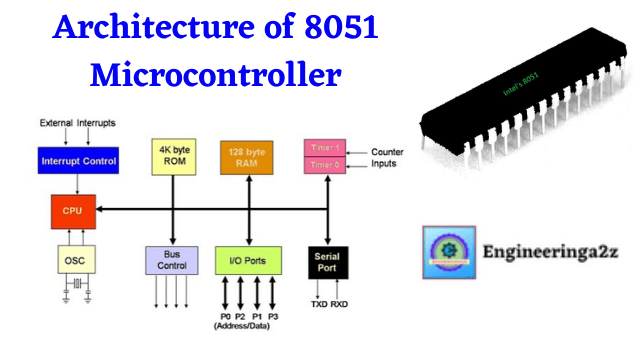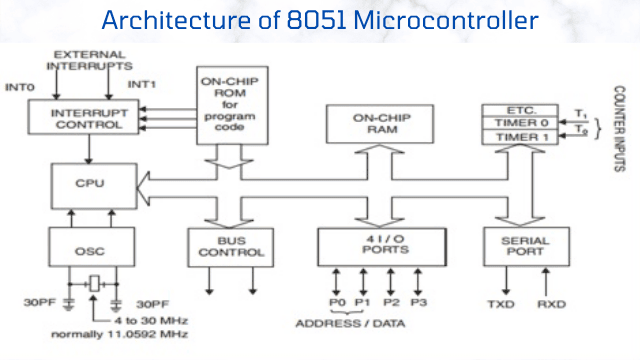
Table of Contents
Architecture of 8051
Basic components present internally inside 8051 microcontroller architecture are:

CPU (Central Processing Unit)
- CPU is the heart of microcontroller. It monitors & controls all operations that are performed on microcontroller units.
- The function of CPU is control the operation of computer. It read the binary coded instruction & generate the control signal required to execute the instruction.
- The user has no power over the functioning of the CPU.
- CPU manages different types of registers in the 8051 microcontroller.
Interrupts Control
Interrupts control has two ways of giving interrupt to microcontroller.
- By sending software instruction.
- By sending hardware instruction.
Their are five Interrupts of the 8051 microcontroller have the following source:
- TF0 (Timer 0 overflow interrupt)
- TF1 (Timer 1 overflow interrupt)
- INT0 (External 0 hardware interrupt)
- INT1 (External 1 hardware interrupt)
- RI/TI (Serial communication interrupt)
Memory
The memory which is used to store the program of microcontroller is known as program memory.
In 8051 microcontroller memory internal 4K byte ROM is used & also 128 byte Of data memory of RAM.
ROM :- It stands for Read Only Memory. It is completely a program memory that means used by the programmer to store the program that are to be executed by the microcontroller.
RAM :- It stands for Random Access Memory. RAM is used to store data for only small time duration. It is also known as the data memory as it stores the data temporily.
Bus Control
Bus is a collection of wires which works as a communication or medium for transfer of data. These buses consists of 8, 16 or more wires of the microcontrollers.
These are of two types:
- Address Bus
- Data Bus
Address Bus :- Microcontrollers 8051 has a 16 bit address bus for transferring the data It is used to address memory location and to transfer the address from CPU to memory of the microcontroller.
Data Bus :- microcontroller 8051 has 8-bit of data bus which is used to carry data of a particular applications.
Oscillator
Oscillator is used to 8051 microcontroller & is provide to clock pulses of CPU. Oscillator is to perform timer operation inside microcontroller it required externally connected oscillator.
Therefore, 8051 uses the two 16-bit counters & timers. For the operation of timers & counters the oscillator is used inside microcontroller.
Input & Output Ports
8051 microcontroller has four 8-bit ports named P0, P2, P1, P3. These ports allow the microcontroller to connect with external devices, machines or other peripherals. Each ports has 8-pins. This the 4 ports jointly comprise 32-pins. All ports are bidirectional.
Timer/Counter
The 8051 microcontroller has two 16-bit programmable timer/counter (Timer 0 – Timer 1). Which can be used either as timer to genarate a timer delay or as counter to count events happing outside the microcontroller.
Frequently Asked Questions (FAQs)
What is the full form of CPU?
CPU stands for Central Processing Unit.
The function of CPU is control the operation of computer. It read the binary coded instruction & generate the control signal required to execute the instruction.What is the full form of RAM?
It stands for Random Access Memory. RAM is used to store data for only small time duration. It is also known as the data memory as it stores the data temporily.
What is the full form of ROM?
It stands for Read Only Memory. It is a type of non-volatile memory used in computers and other electronic devices. Data stored in ROM cannot be electronically modified after the manufacture of the memory device.





Leave a Reply